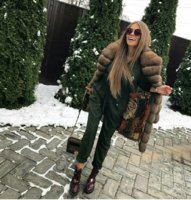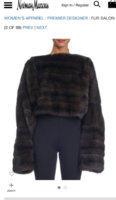I think you are right (bit then I am no expert either). I did hear that some furriers were dying the pelts to give the appearance of the silvery tip. I just don't have the funds for sable but if I did I prefer the darker ones - but honestly they are all beautiful. Looking at the pelts enables a different perspective, as you say it's easier to assess.I am no expert, but I did purchase a 3/4 J. Mendel Barguzin sable coat a few years ago. It is in a medium greyish or ash brown. I wanted that color because I already have a black Dennis Basso mink. It's my understanding that although the most expensive Barguzin sable is near black with a blueish caste, Barguzin sable comes in a number of colors. The number of silvery hair affects the price almost as much as the color of the fur.
Check out the professional sable pelt seller easyfur.com to see the variety of colors available in Sojuzpushnina Barguzin. Looking at the full pelt Without the distraction of fashion or a person wearing the coat gives a better idea of the true color.
https://easyfur.com/search?sSearch=barguzin&p=1
You are using an out of date browser. It may not display this or other websites correctly.
You should upgrade or use an alternative browser.
You should upgrade or use an alternative browser.
Sable in Action
- Thread starter birkin101
- Start date
More options
Who Replied?Some questions:
1)Do you know if there is such a things as farmed verses wild sable? I heard "oh that must be farmed" in one discussion.
2)I was at several high end places and the tags read "tip dyed" and "bleached." The prices were all the same crazy high..............I was told nearly all sable is treated in some way. its minimal but its done to blend the pelts surface color to be more uniform. does this sound right?
I've read that prior to the collapse of the Soviet Union, Russian sable was primarily farmed in state sponsored farms. When the government stopped providing credits to sable farms, farmers could no longer afford to feed the animals and pay employee salaries. As a result many animals died of illness and starvation. Today, most sable from Russia is wild caught by independent hunters who then sell their pelts on the open market or to Sojuzpushnina. As of 2000, there were only 5 Russian sable farms left.
I think you are right (bit then I am no expert either). I did hear that some furriers were dying the pelts to give the appearance of the silvery tip. I just don't have the funds for sable but if I did I prefer the darker ones - but honestly they are all beautiful. Looking at the pelts enables a different perspective, as you say it's easier to assess.
I wonder how they could dye only the tips? That wouldn't shock me, though. Maybe it's like getting our hair highlighted through a cap. Glad that the link was helpful to you. I also found it helpful to see how they rate the number of "silverys" and how much the pelts cost wholesale. There doesn't seem to be much of a correlation between fur color and wholesale price with the Barguzin pelts. The most expensive Barguzin pelts were not the darkest. Even at over $500 USD per pelt, furriers who construct and sell the garments are making a healthy profit. That seems to go triple for the super high end designers. That may be why you sometimes see such drastic reductions in price when the furs are on "sale."
Finally, a natural beauty in a lovely sable coat. What IS it with the Russians and their fish lips, chipmunk cheeks and globbed on makeup? They all look exactly the same.View attachment 3296102View attachment 3296103View attachment 3296104
Lucie de la Falasse attending Christian Dior wearing sable.
Credit to Getty Images
I am no expert, but I did purchase a 3/4 J. Mendel Barguzin sable coat a few years ago. It is in a medium greyish or ash brown. I wanted that color because I already have a black Dennis Basso mink. It's my understanding that although the most expensive Barguzin sable is near black with a blueish caste, Barguzin sable comes in a number of colors. The number of silvery hair affects the price almost as much as the color of the fur.
Check out the professional sable pelt seller easyfur.com to see the variety of colors available in Sojuzpushnina Barguzin. Looking at the full pelt Without the distraction of fashion or a person wearing the coat gives a better idea of the true color.
https://easyfur.com/search?sSearch=barguzin&p=1
You're quite right. Dark means nothing alone. Thick pelts, well matched with wondrous lustre is what really counts.
Hello, everyone. I have not posted on PF in a very long time. Forgive me if someone has mentioned this, but is there some reason why you rarely see a vertically cut sable on these pages or anywhere else these days? I like horizontally worked coats, too, but I still think vertical cuts are lovely and have more natural movement. To me, horizontally worked furs look best on very thin women.
It may be just fashion, but you're right, I also see far fewer full length sables.
I wonder how they could dye only the tips? That wouldn't shock me, though. Maybe it's like getting our hair highlighted through a cap. Glad that the link was helpful to you. I also found it helpful to see how they rate the number of "silverys" and how much the pelts cost wholesale. There doesn't seem to be much of a correlation between fur color and wholesale price with the Barguzin pelts. The most expensive Barguzin pelts were not the darkest. Even at over $500 USD per pelt, furriers who construct and sell the garments are making a healthy profit. That seems to go triple for the super high end designers. That may be why you sometimes see such drastic reductions in price when the furs are on "sale."
It's like adding highlights to hair through little holes for the longer guard hairs. You can usually tell it's dyed as all the colour will be the same and so will the length. Treated pelts are often not even near high quality and mostly male and are often are dyed darker first (leaving a tale-tell dark underside). Like heat treated stones, these pelts are often overdone making them look artificial. Good enough to photo well and to placate Insta users perhaps but naturally good pelts fetch such a high price at auction it's not cost effective as most sable lovers will not touch dyed sable. Years ago you could choose your sable pelts to check the underside and then have whatever style made up. Now the designer names have come like Basso and Tivioli, people have a name to trust and the brand is not going to risk its reputation.
Last edited:
It's like adding highlights to hair through little holes for the longer guard hairs. You can usually tell it's dyed as all the colour will be the same and so will the length. Treated pelts are often not even near high quality and mostly male and are often are dyed darker first (leaving a tale-tell dark underside). Like heat treated stones, these pelts are often overdone making them look artificial. Good enough to photo well and to placate Insta users perhaps but naturally good pelts fetch such a high price at auction it's not cost effective as most sable lovers will not touch dyed sable. Years ago you could choose your sable pelts to check the underside and then have whatever style made up. Now the designer names have come like Basso and Tivioli, people have a name to trust and the brand is not going to risk its reputation.
Thank you for the wonderful info, Paper Tiger! Here are two obscure sites that I really enjoyed:
https://sobol38.ru/en/170516-fur-auction-result-en/
(Info on sable auctions with lots of info on grading skins and color)
http://galakhachaturova.com/en/collection.html
(Sable to die for...)
Last edited:
It seems that lighter sable pelts sold better at auction than the usually coveted dark shades. Interesting.
Unbelievably gorgeous sable garments. The Russians keep the best skins for themselves!
http://galakhachaturova.com/en/history.html
http://galakhachaturova.com/en/history.html
https://sobol38.ru/en/sable-market-analitycs-news-160926-en/
Current state of the Russian Sable market. Fascinating- if you like the nuts and bolts of the industry.
Current state of the Russian Sable market. Fascinating- if you like the nuts and bolts of the industry.
Are thise dyed
I wonder about those low priced "Barguzin" coats out of a certain Eastern European country that you see all over the internet. They look great in the photos, but seem wayyyy too good to be true.
It's like adding highlights to hair through little holes for the longer guard hairs. You can usually tell it's dyed as all the colour will be the same and so will the length. Treated pelts are often not even near high quality and mostly male and are often are dyed darker first (leaving a tale-tell dark underside). Like heat treated stones, these pelts are often overdone making them look artificial. Good enough to photo well and to placate Insta users perhaps but naturally good pelts fetch such a high price at auction it's not cost effective as most sable lovers will not touch dyed sable. Years ago you could choose your sable pelts to check the underside and then have whatever style made up. Now the designer names have come like Basso and Tivioli, people have a name to trust and the brand is not going to risk its reputation.
I wonder about those low priced "Barguzin" coats out of a certain Eastern European country that you see all over the internet. They look great in the photos, but seem wayyyy too good to be true.
I don't really see it's function to be honest. The fur is nice though.Was looking at furs on NM website and this came up described as "oversized pullover"). It's $54,000. I find it odd. More like a throw or a sable snuggy thing.
View attachment 3848449
Register on TPF! This sidebar then disappears and there are less ads!


